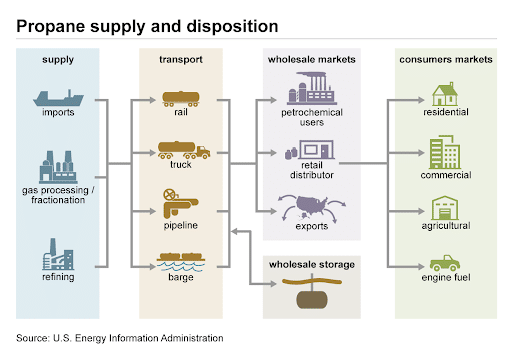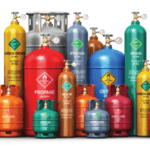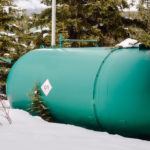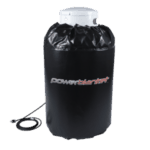The short answer: 18 to 20 hours. However, that time gets much shorter if your tank is exposed to cold temperatures. Read on to learn why that is and what you can do to get the most propane out of your tank.
Understanding propane
How long does a propane tank last? That’s the age-old question everyone seems to ask at the beginning of BBQ and RV season. However, propane tanks are used year-round commercially by manufacturers, construction workers, farmers and more. All users, no matter what background they have or what they’re using propane for, want to get as much out of their tank as they can.
Where does my propane come from?
According to the U.S. Energy Information Administration, propane is created as a side effect of cooling pressurized natural gas and crude oil refining processes. Propane begins deep underground in the form of crude oil and natural gas. Both materials can be processed to create propane gas as a side effect.
Propane is produced domestically, but much of the nation’s propane supply is imported to keep up with consumer demand. Consider the fact that whether you’re using propane to heat up a grill or power a forklift, it could have come from places as far away as the Middle East or as near as South Dakota.
How to make your propane tank last longer
Critical to the production, transport, and eventual use of propane is temperature control. Propane tanks that are too hot due to external temperature impacts are not safe to use and should be moved away from the heat source immediately. Propane tanks that are too cold are safe to use, but there still is a negative effect on the tank if temperatures get too cold.
Temperature impact on propane tanks
As a gas, propane molecules contract as temperatures drop. This means that a full tank will read as less than full in cold weather. Because propane is stored as a liquid, the effect is even greater, causing the fluid level to get lower and lower. As a result, you’ll have to purchase more propane to refill your tanks even though you haven’t used any propane since you last filled it up.
Temperatures also impact the pressure level in your propane tank. If your tank is exposed to temperatures dropping beneath -44 degree Fahrenheit, the propane loses its ability to convert from a liquid into a gas and stays in the tank. No pressure means no propane use, resulting in time needed to warm tanks to a level at which the liquid converts to gas and the propane can be used again.
Cold tanks vs warm tanks
It’s clear that a cold tank of propane is time and money wasted. Propane is one of the most used gasses for heating residential and industrial facilities, but it can’t be used effectively at low temperatures.
Using a cold propane tank reduces the amount of usable propane, resulting in unnecessary refills. Cold tanks also run the risk of not having enough pressure to emit propane when needed. This causes delays in getting heat to materials that must be kept warm and could even lead to expensive replacements of materials that froze while waiting for pressure to build back up.
On the other hand, a warm propane tank has no problems with tank pressure and no need to refill once the tank is full. Simply turn the valve to access propane and get back to your important operations.
Keeping your propane tank warm is essential to preventing propane pressure loss and wasted money, time and materials. Eliminate pressure loss by utilizing tools built for propane tank freeze protection.
Tank Heaters Will Help Your Propane Tank Last Longer
Regardless of tank size, it will need heat to stay ahead of the cold. If you want to guarantee propane use in low temperature environments, wrap your propane tank in a propane tank heater from Powerblanket.
How do tank heaters work?
Powerblanket’s tank heaters begin with heating wires mounted on a graphite backing or printed on a flexible thin film. The heating section has closed-cell foam insulation on one side and a proprietary heat spreading material on the other, providing even heat across the entire surface. A durable chemical and tear-resistant shell protects the core on both sides.
Powerblanket heating jackets for tanks install quickly and easily around any tank, vertical or horizontal, and connect with standard 120v or 240v power. Our tank heaters have optional programmable logic controllers to provide the exact temperature requirements needed for your processes.
Powerblanket can custom-build propane tank heaters for up to 30,000-gallon bulk storage tanks, square or cylindrical. We can provide industrial heating jackets for any tank and fluid, including hazardous locations.
Stop losing money and start getting the most out of your propane with Powerblanket propane tank heaters. Call us at 833.998.2989 or visit our contact us page.
Frequently Asked Questions
How long does a 20lb propane tank last?
A 20-pound propane tank typically lasts 18 to 20 hours on a medium grill, but this can vary based on usage patterns and environmental conditions.
How long does a tank of propane last on a grill?
On a medium grill, a 20-pound propane tank lasts about 18 to 20 hours, while a large grill may use it up in around 10 hours.
How long is a full propane tank good for?
A full propane tank remains usable indefinitely as propane does not expire, but regular equipment inspections are essential for safety and efficiency.
Is it cheaper to refill propane or exchange?
Refilling a propane tank is generally more cost-effective than exchanging, as you only pay for the propane you use.
Keep your propane tanks at the perfect pressure with Powerblanket.





